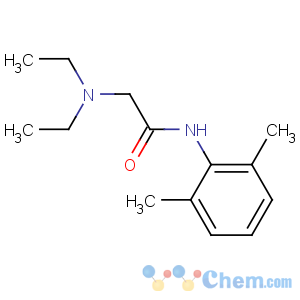You are here:
HomeProductsLidocaine/Lidocaine HCl Anesthetics Pain Reliever Pharmaceutical Powder
Lidocaine/Lidocaine HCl Anesthetics Pain Reliever Pharmaceutical Powder
-
- Product NameLidocaine/Lidocaine HCl Anesthetics Pain Reliever Pharmaceutical Powder
- CAS No.137-58-6
- Purity99%
- Min Quantity1Kilograms
- Price100~2000

 View Contact Detail
View Contact Detail
-

Molecular Structure
Detailed Description
Lidocaine/Lidocaine HCl Anesthetics Pain Reliever Pharmaceutical Powder
1.Product Detials
Lidocaine
Alias: Xylocaine,lignocaine,,Lidocaine Base
Lidocaine CAS Registry Number: 137-58-6
Lidocaine Assay: 99%
Lidocaine Appearance: White crystalline powder
Lidocaine Packing: 1kg foil bag,25kg/drum or as your requirment
Lidocaine EINECS: 205-302-8
Lidocaine Molecular Formula: C14H22N2O
Lidocaine Molecular weight: 234.34
Lidocaine Manufacturer: Holybilological
Usage: Topically used to relieve itching, burning and pain from skin inflammations, injected as a dental anesthetic, or as a local anesthetic for minor surgery.
2.Product Description
Lidocaine, xylocaine, or lignocaine is a common local anesthetic and class-1b antiarrhythmic drug. Lidocaine is used topically to relieve itching, burning, and pain from skin inflammations, injected as a dental anesthetic, or as a local anesthetic for minor surgery.It is on the World Health Organization's List of Essential Medicines, a list of the most important medications needed in a basic healthcare system.
Lidocaine is the most important class-1b antiarrhythmic drug; it is used intravenously for the treatment of ventricular arrhythmias (for acute myocardial infarction, digoxin poisoning, cardioversion, or cardiac catheterization) if amiodarone is not available or contraindicated. Lidocaine should be given for this indication after defibrillation, CPR, and vasopressors have been initiated. A routine prophylactic administration is no longer recommended for acute cardiac infarction; the overall benefit of this measure is not convincing.
3.Applications
The efficacy profile of lidocaine as a local anesthetic is characterized by a rapid onset of action and intermediate duration of efficacy. Therefore, lidocaine is suitable for infiltration, block, and surface anesthesia. Longer-acting substances such as bupivacaine are sometimes given preference for subdural and epidural anesthesias; lidocaine, though, has the advantage of a rapid onset of action.
Epinephrine vasoconstricts arteries, reducing bleeding and also delays the resorption of lidocaine, almost doubling the duration of anaesthesia. For surface anesthesia, several available formulations can be used e.g. for endoscopies, before intubations, etc. Buffering the pH of lidocaine makes local freezing less painful.[2] Lidocaine drops can be used on the eyes for short ophthalmic procedures.
Relative insensitivity to lidocaine is genetic. In hypokalemic sensory overstimulation, relative insensitivity to lidocaine has been described in people who also have attention deficit hyperactivity disorder.In dental anesthesia, a relative insensitivity to lidocaine can occur for anatomical reasons due to unexpected positions of nerves. Some people with Ehlers-Danlos syndrome are insensitive to lidocaine.
Lidocaine, along with ethanol, ammonia, and acetic acid, has also been proven to be effective in treating jellyfish stings, both numbing the affected area and preventing further nematocyst discharge
4. Pharmacodynamics
(1) Anaesthesia
Lidocaine alters signal conduction in neurons by blocking the fast voltage-gated Na+ channels in the neuronal cell membrane responsible for signal propagation. With sufficient blockage, the membrane of the postsynaptic neuron will not depolarize and will thus fail to transmit an action potential. This creates the anaesthetic effect by not merely preventing pain signals from propagating to the brain, but by stopping them before they begin. Careful titration allows for a high degree of selectivity in the blockage of sensory neurons, whereas higher concentrations also affect other modalities of neuron signaling.
(2) Antiarrhythmic
The same principle applies for this drug's actions in the heart. Blocking sodium channels in the conduction system, as well as the muscle cells of the heart, raises the depolarization threshold, making the heart less likely to initiate or conduct early action potentials that may cause an arrhythmia.

- Lidocaine/Lidocaine HCl Anesthetics Pain Reliever Pharmaceutical Powder




